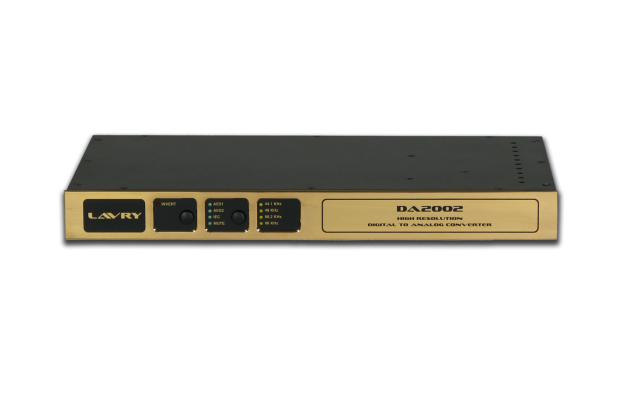LavryGold DA2002
Product Image
Product Description
The LavryGold DA2002 is a precision stereo DA converter intended primarily for high-end HiFi applications; with balanced professional style XLR outputs as well as unbalanced consumer level RCA (IEC) outputs. The output level is fixed (not adjustable). There are two AES/XLR and one SPDIF RCA (IEC) input that accept stereo digital audio inputs.
For more information on the LavryGold DA2002 click here
For general information see digital to analog converter.
Features
- 96kHz, 88.2kHz, 48kHz, 44.1kHz sampling rates with available CrystalLock™
- 40-50kHz wide mode sampling rates
- Multi-bit architecture with 24 bits, non-sigma delta
- Increased low level accuracy
- Fast transient response - no oversampling at 88.1kHz and 96kHz, single stage interpolation at 44.1kHz and 48kHz
- Critical electronic components are thermally stabilized for consistently accurate conversion
- Automatic calibration internally adjusts to aging components, maintaining unit performance over time
- Digital jitter removal
- Professional and consumer input and outputs
- Balanced / unbalanced - internally jumper configurable XLR outputs
- Direct output coupling - no relay in signal path
- Absolute Polarity Inversion
- Automatic scanning of inputs
- Unequalled detail and performance
Applications
- High-end HiFi listening
Connections
Analog outputs
The DA2002 has electronically balanced XLR outputs which can be configured for unbalanced operation using internal jumpers. The unbalanced RCA (IEC) outputs outputs are suitable for connection to consumer level equipment.
- When set for balanced operation, the XLR output for a full-scale signal is 4.5V R.M.S. into 100K Ohm load, 4.2V R.M.S. into 600 Ohms.
- When set for un-balanced operation, the XLR output level for a full-scale signal is 2.2V R.M.S. into 100K Ohm load, 2V R.M.S. into 600 Ohms.
- The RCA (IEC) unbalanced output level is 2V R.M.S. into 100K Ohm load.
The XLR output is Pin 2 "+" and Pin 3 "-" for normal signal polarity when the front panel Polarity setting (“INVERT” switch and LED indicator) is “Off.” Thus, for the DA2002 with balanced or unbalanced XLR Pin 2 "+" connections, the signal polarity is "normal" or "non-inverted." Changing the front panel Polarity setting to “INVERT” (LED indicator illuminated) will result in inverted signal polarity for balanced and unbalanced Pin 2 "+" connections, as well as RCA (IEC) connections.
Digital input
There are (3) stereo digital audio inputs on the rear panel of the DA2002- (2) XLR/AES inputs which can accept either AES/EBU or SPDIF/IEC inputs. SPDIF/IEC sources can be connected using simple wired adapters or adapter cables (no transformer is required or recommended for cable lengths that conform to recommendations for coaxial 75 Ohm consumer digital audio cables). The IEC input can accept SPDIF (IEC 60958 type II) stereo digital audio inputs.
Synchronization
The DA2002 always locks to the incoming digital audio signal and provides excellent immunity from jitter in the incoming signal degrading the DA conversion. For input signal with a sample frequency of 44.1 or 48 kHz, the Lavry exclusive CrystalLock™ mode provides the ultimate in jitter immunity from consumer sources such as a CD player. For digital audio inputs with 88.2 or 96kHz SF, an advanced three-stage PLL provides excellent jitter immunity.
AC Power
The power selector of the DA2002 must be set to the proper AC power voltage before AC power is applied.
See LavryGold voltage setting for details on the AC power voltage setting and accessing the fuses.
Operating tips
- The output level of the DA2002 is set for a peak output voltage consistent with consumer electronics. However, there is no standard for XLR connections in consumer HiFi equipment. Please consult the manufacturer’s information before operating the DA2002 when connected to HiFi equipment with XLR inputs.
The two important details to check are:
- Is the XLR input balanced or unbalanced? Operating the DA2002 with the XLR outputs connected to unbalanced cables or inputs with the internal jumpers set for balanced operation will result in increased distortion. Although the outputs are short-circuit protected for relatively short periods of time, operation of the DA2002 for extended periods without properly setting the internal jumpers for unbalanced operation may result in degradation or failure of the output amplifiers.
- Is the input capable of accepting the DA2002’s rated output levels? If the receiving device has XLR inputs that are balanced, but are not capable of accepting a peak level of 4.2 -4.5 Vrms, you can set the internal jumpers for unbalanced operation. In the vast majority of cases; if the receiving device has balanced inputs it will still operate properly with only a slight loss of noise-rejection performance. Not exceeding the peak input level capability of the receiving device is much more important to sound quality than whether the DA2002 output is operating balanced or unbalanced.
The vast majority of audio equipment with RCA (IEC) inputs can accept the RCA/IEC output level of the DA2002 by design (2V R.M.S.).
- The DA2002 has a sophisticated self-calibration system that initializes every time the unit is powered. There are two stages of self-calibration; one which normally takes longer than the other. The first stage is initialization of the temperature-controlled “oven” which maintains the temperature of critical circuit elements. Once the “oven” temperature has stabilized, the second stage of calibration begins and ensures accurate conversion, even as components age. If the power is cycled after the DA2002 has been in operation, the first stage is normally “skipped” or completes rapidly and only the second stage calibration ensues.
- The DA2002 employs a linear power supply and generates a fair amount of heat in normal operation; so do not operate the unit in a manner that does not provide adequate ventilation. Ideally, no other equipment should be placed directly on top of or below the unit. Factors such as the ambient temperature and range of temperature variation will affect how much space is needed to provide adequate ventilation.
Software
The current revision of software which is visible on the label of the PROM on the Main board is: V1.1
